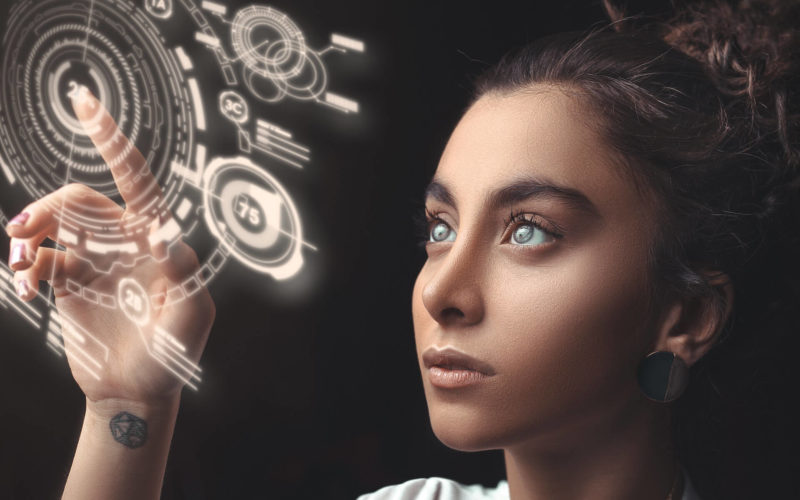Augmented reality is a technology that allows virtual elements to be superimposed on the real world, allowing for a unique immersive experience. In this article we are going to talk about what augmented reality is and how it is being used in different areas.
What is augmented reality??
Augmented reality is a technology that allows virtual objects to be superimposed on the real world through a mobile device, a smart screen or glasses. This is achieved through the use of cameras, Sensors and software that recognize the location and movement of the device and real-world objects.
Augmented reality differs from virtual reality in that instead of creating a virtual world, Overlays virtual objects on the real world. In this way, Augmented reality allows users to have an immersive experience in the real world, at the same time that virtual elements are added to it.
How does augmented reality work?
Augmented reality combines virtual elements with the real world to create an interactive and enriching experience. Unlike virtual reality, that creates a completely new world separated from reality, Augmented reality improves and enriches existing reality.
To achieve this, Augmented reality technology uses a variety of tools and techniques, such as pattern recognition, object detection, geolocation and integration of sensors and cameras.
When used on mobile devices such as smartphones or tablets, The device's camera scans the real world and detects objects, Specific patterns or locations. Later, Augmented reality technology overlays images, Videos, Sounds or other virtual elements on the device screen to create an augmented reality experience.
In addition to mobile devices, Augmented reality can also be used in dedicated hardware devices, such as smart glasses or augmented reality headsets. These devices are specifically designed to provide an immersive augmented reality experience., allowing greater interaction with the digital world and physical reality.
Applications of augmented reality
Augmented reality is being used in a wide variety of fields, From entertainment to industry and medicine. Some of the most prominent applications are:
- Entertainment: Augmented reality is used in video games and mobile apps to create more immersive gaming experiences. It is also being used in shows and concerts to create special effects and visuals..
- Advertising: Augmented reality is being used in advertising to create interactive ads that allow users to interact with products and see how they would look in the real world..
- Education: Augmented reality is being used in education to create more interactive and engaging learning experiences. Students can explore 3D models of abstract objects and concepts in the real world.
- Industry: Augmented reality is being used in industry to improve production processes and worker training. Workers can view real-time information about equipment and production processes, allowing them to work more efficiently and safely.
- Medicine: Augmented reality is being used in medicine to create education and coaching experiences for healthcare professionals. It is also being used in healthcare to improve diagnosis and treatment of patients.. For example, Augmented reality can be used to overlay patients' information on the human body to better visualize the parts affected by a disease or injury..
Therefore, Augmented reality is used in a wide variety of fields, such as advertising, Entertainment, Education, Medicine, Architecture and industry, among others. This technology is increasingly invested due to its potential to improve the user experience and increase interaction with the digital world..
Challenges and limitations of augmented reality
Although augmented reality has great potential, It also faces challenges and limitations that must be addressed for widespread adoption in the industry and in everyday life.. Below are some of the main challenges and limitations of augmented reality.:
- Hardware and software: Augmented reality requires specialized hardware and software to function properly. Augmented reality devices like helmets and goggles can be expensive and may not be light or comfortable enough for everyday use.. In addition, The software technology needed to create high-quality augmented reality experiences can also be expensive and complex..
- Accuracy and reliability: Accuracy and reliability are critical for augmented reality to be effective. Augmented reality systems must be able to track the user's movement and recognize and track objects in the real world accurately. Any error or delay in tracking user position or object detection can disrupt the augmented reality experience and make it less effective.
- Content and creativity: Augmented reality is a relatively new and constantly evolving technology, And there are still limitations in terms of content and creativity. Developers must create compelling and relevant content for augmented reality that can engage users and keep them engaged.. In addition, Content creators need to be creative and find innovative ways to use augmented reality to deliver new and engaging experiences..
- Privacy & Security: Augmented reality also raises privacy and security concerns. Augmented reality technology can allow users to access personal and confidential information, and can also enable tracking and collection of location and movement data. Augmented reality developers need to be aware of these issues and work to address them appropriately..
Despite these challenges and limitations, Augmented reality remains an exciting and promising technology with the potential to transform the way we interact with the world around us. With continuous innovation and development of hardware and software, as well as the creation of creative and relevant content, Augmented reality will continue to evolve and improve in the coming years.
Future perspectives of augmented reality
In the future, Augmented reality is expected to become an even more ubiquitous and useful technology in a variety of fields.. For example, in manufacturing, Can be used to improve production efficiency and safety at work by displaying real-time instructions and guides. In the education sector, Augmented reality can provide new ways of learning and more immersive and effective learning experiences.
Augmented reality is also expected to have a significant impact on how businesses interact with consumers.. Retailers can use augmented reality to create more interactive and personalized shopping experiences, allowing consumers to see how products will look before they buy them. Advertising and entertainment industries can also leverage augmented reality to create more impactful and immersive advertising campaigns and entertainment experiences..
Augmented reality is at a stage of rapid development and is expected to have a significant impact on a variety of fields in the near future.. As new technologies are developed and current challenges are overcome, Augmented reality will continue to evolve and transform the way we interact with the digital and physical world..
Conclusion
Augmented reality is a technology increasingly present in our lives, with a wide range of possibilities in different areas, from entertainment and video games to education, Medicine and industry. While there are still challenges and limitations that need to be overcome, such as the need for more accessible and affordable devices, and greater accuracy in object detection and tracking, Augmented reality continues to evolve and promises to continue transforming the way we interact with the digital and physical world.






